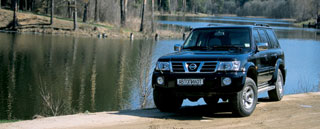Test drive Nissan Patrol LWB 1998 - 2004 SUV
On roads and directions
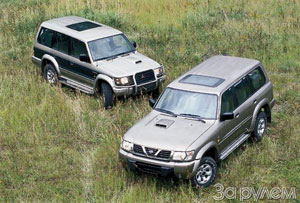 Mitsubishi-Pajero Mitsubishi Pajero
Mitsubishi-Pajero Mitsubishi Pajero Mitsubishi Pajero of the current generation appeared in 1991. It is produced with short-paved three- and long-standing five-door bodies in the trim levels GL, GLX and GLS. It is equipped with 2.5- and 2.8-liter diesel engines with turbocharges or 2.4-, 3.0 and 3.5-liter gasoline. Gearboxes - five -speed mechanical or four -speed automatic.
Nissan Patrol Nissan Patrol
The new Nissan Patrol Gr/›Nissan Patrol debuted at the 1997 Frankfurt Car Show. It is produced with short-paved three- and long-standing five-door bodies in trim levels S and SE. It is equipped with 2.8- and 4.2-liter turbocharged diesels or a 4.5-liter gasoline engine. Gearboxes - a five -speed mechanical or four -speed automatic.
Any car is a compromise between different, sometimes mutually exclusive requirements. This applies to an all -terrain vehicle - it is simply woven from compromise solutions, because the range of its application is very wide. However, each company sees the best combination of qualities in its own way. Which of the all -terrain vehicles is better? The question is very difficult - let's understand together. In the first of the planned series of off -road tests, Mitsubishi Pajero and Nissan Patrol Gr/›Nissan Patrol fell together. To equalize their chances, we have chosen the same 2.8-liter turbodiesel modifications in the richest GLS and SE assemblies worth $ 48,878 and $ 49,500, respectively.
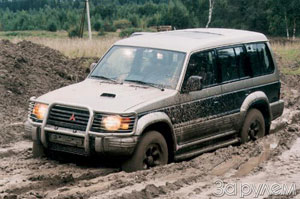 The six -year difference in the age of two all -terrain vehicles outside is almost not noticeable, although the Nissan Patrol Gr/›Nissan patrol looks a little more elegant. Inside the differences are more significant. The point is not only in the archaic panel of the instruments of Mitsubishi Pajero. By her deliberate roughness, she rather emphasizes the functionality of the interior, in which alien rubber boots and a hunting jacket will not look like alien. The fact that you are sitting in an all -terrain vehicle will not allow you to forget the juper set of devices - compass, rollomer, altimeter. In luxurious-kozhan, with inserts under the tree of the patrol, a business suit and even an evening dress will turn out to be more appropriate. The off -road capabilities of the car resemble only the lever of the hand -box. Otherwise, here as in a large passenger universal. Settle to sit here is more convenient - the doorway is higher. The second row of seats is slightly more spacious, landing on the third is tangibly more comfortable due to the lower floor level.
The six -year difference in the age of two all -terrain vehicles outside is almost not noticeable, although the Nissan Patrol Gr/›Nissan patrol looks a little more elegant. Inside the differences are more significant. The point is not only in the archaic panel of the instruments of Mitsubishi Pajero. By her deliberate roughness, she rather emphasizes the functionality of the interior, in which alien rubber boots and a hunting jacket will not look like alien. The fact that you are sitting in an all -terrain vehicle will not allow you to forget the juper set of devices - compass, rollomer, altimeter. In luxurious-kozhan, with inserts under the tree of the patrol, a business suit and even an evening dress will turn out to be more appropriate. The off -road capabilities of the car resemble only the lever of the hand -box. Otherwise, here as in a large passenger universal. Settle to sit here is more convenient - the doorway is higher. The second row of seats is slightly more spacious, landing on the third is tangibly more comfortable due to the lower floor level. The driver of Mitsubishi will have to be settled behind the wheel, but not because of the lack of electrical adjustments. The fact is that with growth, say, 180 cm to see the devices through the bagel, the driver is forced to raise the steering wheel up, placing it almost in the battleship horizontally. But thanks to a slightly higher landing and a relatively short slope hood, the driver Pajero is better than visibility forward. Tall drivers will appreciate the high ceiling, but in the patrol they will clash the panel with their knees. In the inner mirror of both all -terrain vehicles, mainly a spare wheel and head restraints of the second row are visible. Well, now we compare colleagues in motion.
Roads
 City streets and highways forced to fundamentally change the idea of \u200b\u200btwo cars. At first, perceived as an inert, low -speed rogue, Pajero unexpectedly showed magnificent dynamic qualities. From 2000 to 4000 rpm, the motor demonstrates enviable redness and good elasticity. However, outside this range, the engine is either still or no longer pulling. Therefore, when acceleration of transmission, they are perceived as very short. But the patrol of the expected passenger dynamics did not show. He sluggishly (albeit evenly) accelerated in the entire range of revolutions, confirming his efforts by the whistle of the turbine. In general, if the driver of Mitsubishi received pleasure from overtaking, then Nissan is unlikely. In addition, the latter turned out to be difficult to dose traction on small gas. When smoothly pressing the pedal after braking by the engine, the latter does not react immediately, and then, as if waking up, turns on with double zeal.
City streets and highways forced to fundamentally change the idea of \u200b\u200btwo cars. At first, perceived as an inert, low -speed rogue, Pajero unexpectedly showed magnificent dynamic qualities. From 2000 to 4000 rpm, the motor demonstrates enviable redness and good elasticity. However, outside this range, the engine is either still or no longer pulling. Therefore, when acceleration of transmission, they are perceived as very short. But the patrol of the expected passenger dynamics did not show. He sluggishly (albeit evenly) accelerated in the entire range of revolutions, confirming his efforts by the whistle of the turbine. In general, if the driver of Mitsubishi received pleasure from overtaking, then Nissan is unlikely. In addition, the latter turned out to be difficult to dose traction on small gas. When smoothly pressing the pedal after braking by the engine, the latter does not react immediately, and then, as if waking up, turns on with double zeal. Large base and track, as well as asphalt rubber allowed Nissan a little more confidently to stay in corners. He also turned out to be the brakes. The disconnecting of the rear reptile stabilizer on the behavior of the machine almost did not affect.
Well, we got to the places, for the sake of overcoming which, in fact, they buy an all -terrain vehicle, and not an ordinary passenger car. Here the roads turn into
DIRECTIONS
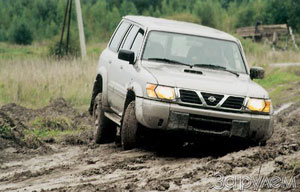 The first test is a swampy meadow. Both cars are confidently moving along it with one rear -wheel drive. But they can no longer move off after a five -minute stop - the wheels failed. After connecting the front bridge, Nissan leaves, and Mitsubishi continues to dig the ground with the rear wheels, although the first is staffed by the usual summer tires of Bridgeto Deweler, and the second - with toothy winter. It’s all about the different possibilities of transmission, because the patrol does not have the center differential and both bridges immediately turn out to be strictly connected. However, it is difficult to recognize this with the advantage: after all, in this mode, one cannot move for a long time due to increased loads in the transmission. In addition, you can’t switch the modes (except 4N -2N) on the go: I didn’t realize immediately to switch to all -wheel drive or a low row - you will have to stop at the risk of sitting down. At Pajero, the transmission super select makes it possible to switch on the go, and the center differential allows you to use all -wheel drive for a long time. In difficult conditions, the differential is blocked.
The first test is a swampy meadow. Both cars are confidently moving along it with one rear -wheel drive. But they can no longer move off after a five -minute stop - the wheels failed. After connecting the front bridge, Nissan leaves, and Mitsubishi continues to dig the ground with the rear wheels, although the first is staffed by the usual summer tires of Bridgeto Deweler, and the second - with toothy winter. It’s all about the different possibilities of transmission, because the patrol does not have the center differential and both bridges immediately turn out to be strictly connected. However, it is difficult to recognize this with the advantage: after all, in this mode, one cannot move for a long time due to increased loads in the transmission. In addition, you can’t switch the modes (except 4N -2N) on the go: I didn’t realize immediately to switch to all -wheel drive or a low row - you will have to stop at the risk of sitting down. At Pajero, the transmission super select makes it possible to switch on the go, and the center differential allows you to use all -wheel drive for a long time. In difficult conditions, the differential is blocked. Now the second test is hillocks and ditches. We start again with the rear -wheel drive. Long -flow suspension gives advantages to the patrol - the wheels are better monitored by irregularities. Diagonal hanging used to occur at Pajero, forcing the driver to block the differential of the rear axle. By the way, the patrol has the same blocking.
The third test is a sandy quarry. Transmissions are activated as much as possible: a reduced row and all locks. In this mode, we could not plant all -terrain vehicles. They confidently plowed the quarry along and across, like bulldozers crowned loose crests. Because of the tires, only a little less confidently Nissan walked.

And finally, the apotheosis of the tests is a clay mess. Dirt with a capital letter. The first to storm the patrol - and is sitting almost immediately. The protector clogged with dirt, the wheels turned into some clay slugs. Neither low gear nor locks help. We back up in reverse, but after a couple of meters - again a stop. Again forward - back ... Attempts with the tenth patrol pierced the track and got out of the mud. The next mess is storming Pajero. He succeeds better: a large tread pattern helps to pass on the third attempt. Having earned the cars to the roofs, we were convinced that with equal maximum possibilities of transmission on off -road, they solve a large road clearance and off -road qualities of tires. The patrol has more potential here: huge wheel niches allow you to install almost Big-foot wheels.
So, the meeting is finished, rivals are divorced in their corners. What are the results?
Completion (General position)
Alloy wheel wheels, a full-sized spare wheel in a case, steps, corrector and headlight washer, adjustable pause of wipers, cleaner/detector/rear window heater, central castle, beta-switch, immobilizer, electric windows and mirrors adjustable steering, heating the front ones. Seats, split (50:50) The second row seat, folding seats of the third row, air conditioning, clock, external thermometer, compass, audio training.
Mitsubishi-Pajero 2.8TD in the GLS configuration
A transparent transparent hatch with electric drive, adjustment of movement (two mechanical) and stiffness of the seats, head restraints of the third row, a driver’s seat pillow, two batteries, an additional heater with a separate remote control, a roller, a height, opening the rear side windows.
Nissan-patrol 2.8td in the SE configuration
The headlight cleaner, a sliding/lifting transparent hatch with an electric drive, four electric seats adjustments, two front airbags, a leather interior trim, wood inserts, a double -leaf -back door.
Technical characteristics of the car
 Mitsubishi Pajero 2.8td (passport data)
Mitsubishi Pajero 2.8td (passport data) General data: number of places - 7; Equipped mass - 2010 kg; Full mass - 2720 kg; maximum speed - 150 km/h; acceleration time from a place to 100 km/h - 16.8 s; fuel consumption in conditional suburban and city cycles - 9.7; 14.0 l/100 km; fuel supply - 92 l; Fuel is diesel. Dimensions, mm: length - 4700; width - 1695; height - 1890; base - 2725; The track in front/back - 1465/1480; minimum road clearance -215; trunk volume - 280/1350/2600 l; The turning radius is 5.9 m. Engine: diesel with turbocharged and intermediate cooler, four -cylinder in order, located in the front longitudinally; working volume - 2835 cm; cylinder diameter and piston stroke - 95.0x100.0 mm; compression degree - 21.0; Power - 92 kW/125 liters. With. at 4000 rpm; The maximum torque is 292 N.M at 2000 rpm. Transmission: all -wheel drive with a disconnected front bridge; The front differential - free, interase and rear - with forced locks, front wheels - with automatic connection; gearbox - mechanical five -speed; Transporting numbers: I - 3.95; II - 2.24; III - 1.40; IV - 1.00; V - 0.76; h. X. - 3.55; The main program is 4.90; handout: I - 1.00; II - 1.93. Design: supporting steel frame, a body on rubber pillows. Suspension: with reptile stabilizers, in front - independent torsioned on double transverse levers, behind - a dependent spring, with four longitudinal rocket rods and Panar's thrust. Brakes: hydraulic disk with a vacuum amplifier and ABS, the front are ventilated. Steering: with a hydraulic wrap, such as a screw-shared nut. Tire size: 265/75R15.
Technical characteristics of the car

Nissan Patrol Gr/›Nissan Patrol 2.8TD (passport data)
General data: number of places - 7; equipped mass - 2190 kg; Full mass - 2920 kg; maximum speed - 155 km/h; acceleration time from a place to 100 km/h - 18.4 s; fuel consumption in conditional suburban and city cycles - 9.5; 14.5 l/100 km; fuel supply - 95 liters; Fuel is diesel. Dimensions, mm: length - 5010; width - 1930; height - 1855; base - 2970; The track in front/back - 1605/1625; minimum road clearance - 210; The volume of the trunk is 303/1235/2226 l; The turning radius is 6.1 m. Engine: diesel with turbocharged and intermediate cooler, six -cylinder in order, located in the front longitudinally; working volume - 2826 cm; cylinder diameter and piston stroke - 85.0x83.0 mm; compression degree - 21.8; Power - 95 kW/130 liters. With. at 4000 rpm; The maximum torque is 252 N.M at 2000 rpm. Transmission: all -wheel drive with a disconnected front bridge; The front differential - free, rear - with forced locking, interdosseous - is absent; front wheels hubs - with automatic connection; gearbox - mechanical five -speed; Transporting numbers: I - 4.06; II - 2.36; III - 1.49; IV - 1.00; V - 0.86; h. X. - 4,12; The main gear is 4.62; handout: I - 1.00; II - 2.02. Design: supporting steel frame, a body on rubber pillows. Suspension: a dependent spring with panar rods and reptile stability stabilizers (back - disconnected); in front - on two longitudinal levers; Behind - on four longitudinal rocket rods. Brakes: hydraulic ventilated disk with a vacuum amplifier and ABS. Steering: with a hydraulic wrap, such as a screw-shared nut. Tire size: 265/70R16.
SUMMARY
Mitsubishi Pajero 2.8td is more dynamic and allows the driver to feel more confident on a slippery road, constantly using all -wheel drive. The Nissana -Patrol 2,8TD has a rather soft comfortable suspension and a rich interior decoration. If you are a jipper in your shower, take care of choosing the right tires.
The editors thank the company Rolf Holding Ko and Avto'Kay for the cars provided for test.
Detailed sales information in the dealer price section.


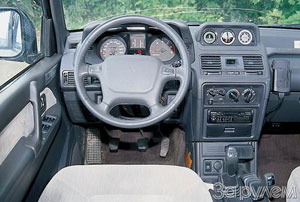

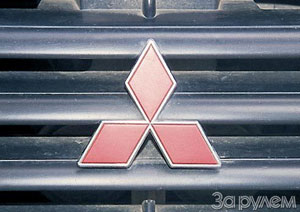
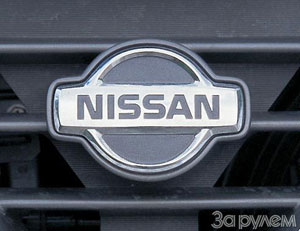
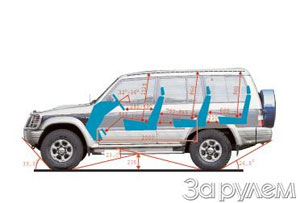
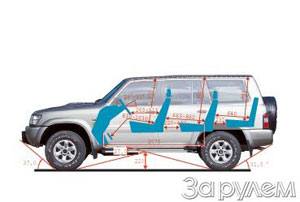
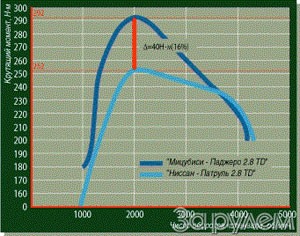

Yuri Nechetov
Photo by Vladimir Knyazev and Igor Traponov
A source: The magazine "Driving"









